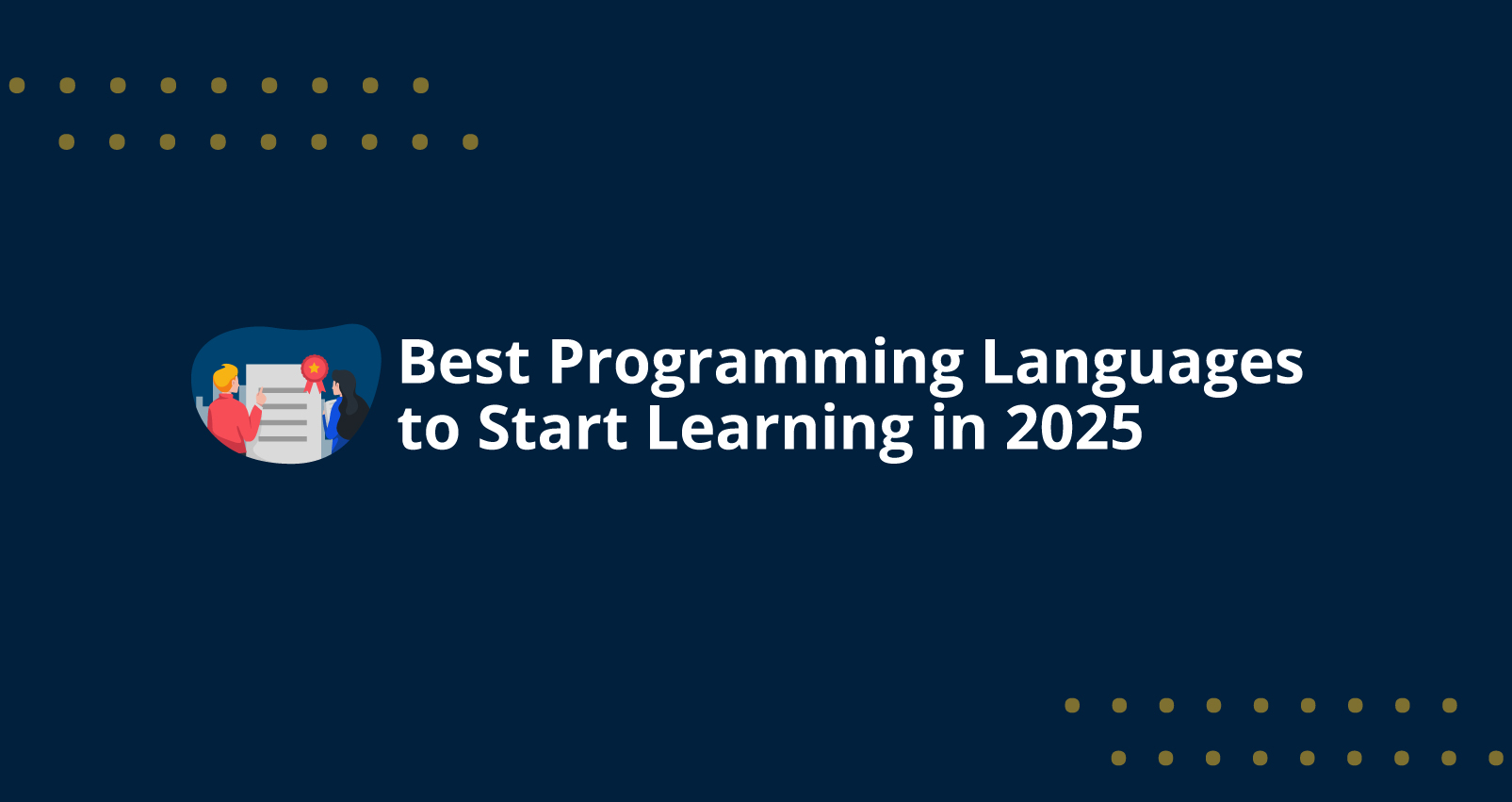Introductions:
The field of programming is never in a stalemate. Every year, we observe changing trends in the field as languages evolve to adapt to the changing needs of fields like AI and blockchain, as well as data science and IoT. Technology is constantly evolving, and with the advent of new technologies, choosing a programming language can have an enormous difference in the direction of your career, depending on whether you're dipping into machine learning, web development applications, or mobile or embedded systems.
The 2025 world of programming will be a mixture of well-established favourites and innovative newcomers. Learning which languages are increasingly recognized and the reasons behind their growth could help developers, IT professionals, and technologists make educated choices regarding their education paths. This guide will highlight some of the most influential languages, which will determine technology's future and give insight into what they can do to help you remain competitive in the current business.
The list has been compiled by analyzing trends in the learning platform and reports from the industry and tech community and ensuring that it accurately reflects the current needs and potential. From general-purpose languages to instruments for fields like functional programming, concurrent programming and statistical computation, this article includes everything.
Why are Programming Languages in Demand?
Demand for experienced programmers is increasing quickly across all sectors. Many companies are investing in the latest technology to keep up with the competition, resulting in the need for developers.
The 2025 year is when learning how programming will not just improve your employment prospects but also provide you with the capability to resolve complex problems, automate processes, and create creative solutions. It doesn't matter if you're beginning a new career in technology or are looking to improve your capabilities; programming can be an effective instrument.
Innovative technologies such as AI Blockchain, AI and IoT change the technological world. Learning the correct programming language will put your company at the cutting edge of the latest innovations. There's more to programming than just websites anymore. It's now about designing smart systems that shape the future.
What Are the Best Programming Languages to Learn in 2025?
For people who are interested in systems-level programming and performance, Rust and Go stand out. They are able to provide security for memory and concurrency. This makes these popular options for backend systems as well as infrastructure development.
When it comes to mobile app design, Kotlin and Swift are indispensable. As mobile devices are dominating the digital world, these languages are vital for the development of Android as well as iOS apps.
Since artificial intelligence, machine learning, and data analysis continue to expand, the use of languages such as Python, R, and Julia is essential for the development of complicated algorithms and predictive models.
More people are adopting Blockchain technology; more people are adopting Blockchain Solidity along with Rust, which can be used to create applications that are decentralized (dApps) in addition to smart contracts, which provide safe and reliable solutions based on blockchain technology.
Here is a list of categories of Best Programming Languages to Learn by 2025. This list will assist you in choosing the best program based on your objectives and ensure you are prepared for the rapidly changing technological world.
1. Python
Python remains among the most adaptable and easy-to-learn languages. It's widely utilized in the fields of data science, machine learning and web development. Python is one of the big standard libraries & supportive communities make perfect learning for beginners & experts also.
Features:
- Simple-to-read syntax
- Libraries that are extensive for AI, ML, and data science
- Support for multi-paradigms (OOP and functional)
Uses: Information science and AI and web design Automation, scripting, as well as backend programming
2. JavaScript
JavaScript is vital for front-end web development. JavaScript is constantly evolving using frameworks such as React, Angular, and Node.js. JavaScript is a fundamental component of present web development, enabling everything from basic animations to intricate web apps.
Features:
- Important for front-end development of websites
- The software supports server-side as well as client-side scripting (Node.js)
- Frameworks that are versatile (React and Angular, Vue)
Uses: Web development, mobile app development, game development, front-end development, server-side applications
3. Java
Java is one of the top options for building robust and flexible applications, particularly enterprise applications. Most of the high-level enterprise-level applications & android application development organizations utilize that. That's why this language is called "write once, Run anywhere.”
Features:
- Platform independent using JVM. JVM
- Secure and robust, with the ability to scale
- OOP principles. OOP Principles of OOP
Uses: Enterprise apps, Android app development, backend systems and financial services
4. C++
C++ is known for its speed and performance. This language is based on C. It is extensively used for game development, system-level programming, and application development. In real-time and resource-constrained applications, its effectiveness and efficiency are extremely important.
Features:
- High-performance language
- Direct hardware control
- It supports both object-oriented and procedural programming
Uses: Development of games, programming systems, embedded systems, and critical applications that require performance
5. C#
C# is developed by Microsoft. This is one of the powerful languages used for developing applications on the .NET framework. It’s particularly popular in game development using Unity.
Features:
- Part of the .NET framework
- Supports Windows applications and Unity game development
- Strong type-safety features
Uses: Web development, game development (Unity), and enterprise applications
6. Go (Golang)
Go is well-known for its efficiency, simplicity & reliability when it comes to handling massive systems. It is being increasingly employed for cloud-based infrastructure. This is developed by Google. Also, It is perfect for cloud applications because of its lightweight concurrency approach.
Features:
- It was developed by Google for scaling
- Excellent concurrency support
- Fast and minimalist
Uses: Cloud computing backend services, cloud computing distributed systems, and microservices.
7. Rust
Rust is a language focused on performance and safety, which makes it an excellent option for programming at the system level. Its memory management & concurrency are more beneficial for creating the most secure & effective Software.
Features:
- Security of memory with no garbage collection
- Focus on performance with a strong emphasis on the ability to work together
- Secure through design
Uses: Web assembly, system programming blockchain, system programming, and embedded technology
8. Kotlin
Kotlin is the most preferred method of Android application development. It offers the most concise and secure programming than Java.
Features:
- Fully compatible with Java
- Simple and expressive syntax
- The official language of Android development
Uses: Android application development, server-side development, and web-based apps
9. Swift
Swift is the most popular software development language used to build applications for the Apple ecosystem. It includes iPhone, iPad, and Mac. This is designed to provide secure, quick & creative design that can produce high-performing applications for iOS & macOS.
Features:
- Developed by Apple
- Fast and safe syntax
- Playgrounds with interactive play for the purpose of testing
Uses: iOS application design, macOS applications, and Apple ecosystem software
10. R
R is extensively used in analyses of data & application of statistics, which makes R a favourite among data scientists.
Features:
- Built to facilitate statistical analysis
- Libraries for the visualization of data that are extensive
- Flexible and open-source
Uses: Machine learning, data analysis, statistical computing, visualizing data
11. PHP
Although it is an older software, it is mostly used as a server-side scripting language. PHP powers a large part of the internet and includes platforms such as WordPress & other content management systems & applications.
Features:
- Server-side scripting language
- Powers popular CMS platforms like WordPress
- A large and active community for open-source
Uses: Website development and design, responsive websites, and systems for content management
12. TypeScript
TypeScript is a variant of JavaScript that includes static typing. This makes it much easier to develop scalable web applications.
Features:
- Use static typing to increase dependability
- supports additional tools for contemporary JavaScript features
- integration with JavaScript libraries that is smooth
Uses: Front-end and back-end development
13. Ruby
Ruby is a popular choice due to its simplicity and productivity, and it is commonly employed in web development using its Ruby on Rails framework. It’s very easy to learn & understand.
Features:
- Its focus is on efficiency and simplicity
- Metaprogramming support is available
- Includes the Ruby on Rails framework
Uses: Automation scripts, Web design and prototyping
14. SQL or Structured Query Language
SQL is the foundational language for maintaining & manipulating the database. This is crucial for coordinating the relational database and querying it, an essential skill for professionals working in data. As it offers a strong, standardised syntax, SQL has been crucial to database administration for many years.
Features:
- Standard language used for relational databases
- It can handle complex joins and queries.
- Commonly employed in the manipulation of data
Uses:
- Data management, analysis, business intelligence, and data management.
15. Scala
Scala is a programming language that blends functional and object-oriented programming. It is used extensively for data processing.
Features:
- Functional programming combines object-oriented and functional programming.
- Runs on the JVM
- Inference of type with strong force
Uses:
Backend and data processing and distributed system
16. Dart
Google Dart is the programming language that powers Flutter, the framework that allows the creation of cross-platform mobile applications.
Features:
- Developed by Google
- It compiles native code
- Utilized with Flutter to create applications that run on multiple platforms
Uses:
Mobile app development (Flutter), web development.
17. Shell Scripting
Shell scripting is an essential technique for automating routine tasks and handling systems.
Features:
- Command-line interface automation
- Simple to understand for Linux users
- Helps with task automation
Uses: Administration of systems, automation and administration of servers.
18. MATLAB
MATLAB is used extensively in scientific research and engineering due to its advanced computational capabilities. It’s a very high-level language. As it has strong mathematical capabilities, which make it perfect for engineering, scientific research, and challenging numerical jobs, it is well-liked in both academia and industry.
Features:
- Command-line interface automation
- It is easy to master for Linux users
- Helps with task automation
Uses: Administration of systems, automation and administration of servers
19. Perl
Perl is well-known for its robust text-processing capabilities, and it is frequently utilized in bioinformatics. Network programming, web creation, and system administration all make extensive use of it.
Features:
- The ability to process text is strong.
- Supports regular expressions
- Dynamic and flexible
Uses: Web development, system administration, Bioinformatics and web development.
20. Lua
Lua is an extremely light and speedy high-level scripting language, which makes it perfect for embedded and game development applications. It is also designed to create simple syntax.
Features:
- Lightweight scripting language
- It is embeddable into applications
- Simple to master
Uses: Game creation, embedded systems and scripting.
21. Haskell
Haskell is a pure functional programming language renowned for its mathematical methodology. This language is well-known for its expressive syntax and focus on immutability, which helps to keep code from having unintended consequences.
Features:
- Functional programming is a pure language.
- The Strong Type System
- In academic research
Uses: Research, academic projects, and programming for functional purposes
22. Elixir
Elixir is based on the Erlang VM and can be used to build fault-tolerant, scalable, and reliable applications.
Features:
- Built on the Erlang VM
- Flexible and fault-tolerant
- Apps that run in real-time
Uses: web development and distributed systems, as well as real-time apps
23. F#
F# is a functional-first programming language that runs on the .NET framework. It is renowned for being compatible with other languages, such as C#, and having a simple syntax. F # will be helpful to developers looking for a combination of object-oriented and functional programming paradigms.
Features:
- Functional-first languages
- This supports object-oriented as well as functional programming
- Uses the .NET framework
Uses: Web-based applications, data analysis and financial modelling.
24. Objective-C
While it has been largely replaced with Swift, Objective-C is still utilized to maintain old Apple apps.
Features:
- The language of the past is available for iOS as well as macOS applications
- Fully compatible with Swift
- OOP support is strong. OOP Support for OOP
Uses: Updating old Apple apps.
25. Julia
Julia is a powerful program that can be used for data science and computations.
Features:
- It is designed for high-performance computational
- A simple syntax that is suitable for applications with a lot of math
- It supports distributed and parallel computing
Uses: Machine learning, data science and research in science
26. Bash
The Bash scripting language is crucial to manage Linux platforms and for automating work.
Features:
- Command-line scripting interface
- Automates repetitive tasks
- Cross-platform
Uses: Automatization, management of systems, and scripting.
27. Clojure
Clojure is an operational programming language that is run within the Java Virtual Machine (JVM).
Features:
- Functional language in the JVM
- Immutable data structures
- Syntax that is concise
Uses: Data processing, web development, and concurrent programming
28. Solidity
Solidity is the language used to create smart contracts on Ethereum and other blockchain platforms.
Features:
- The language of smart contracts for Ethereum
- It supports inheritance as well as libraries.
- Decentralized and secure
Uses: Blockchain technology and Smart Contracts.
29. Erlang
Erlang is famous for creating fault-tolerant devices, particularly in the field of telecommunications.
Features:
- Created for systems that are fault-tolerant
- It supports concurrent processes
- Highly adaptable
Uses: Systems for telecom, messaging apps & distributed systems
30. Scratch
Scratch is a language for beginners that introduces kids to coding concepts by using visually-based blocks.
Features:
- Superset of JavaScript that includes static typing
- Cleanly compiles JavaScript
- Perfect for applications with a large scale.
Uses: Web development for front-end and back-end and scalable web-based applications.
Conclusion:
The technologies that are shaping the technology landscape stress the importance of flexibility and specialization regardless of whether you're creating innovative web-based applications, participating with advanced analytics of data, or implementing innovative solutions to difficult problems. If you can align your abilities with those of the sector, you'll have the chance to open many opportunities, be successful in a variety of technical areas, and stay relevant in a constantly evolving digital age.
To help those who want to master an extremely flexible and desired skill sets and skill sets, this Full Stack Developer Masters program is a great option. It provides comprehensive, practical training in MongoDB, Express.js, React and Node.js that will enable the user to develop flexible and scalable web-based applications and advance your career within the competitive field in software engineering.



















